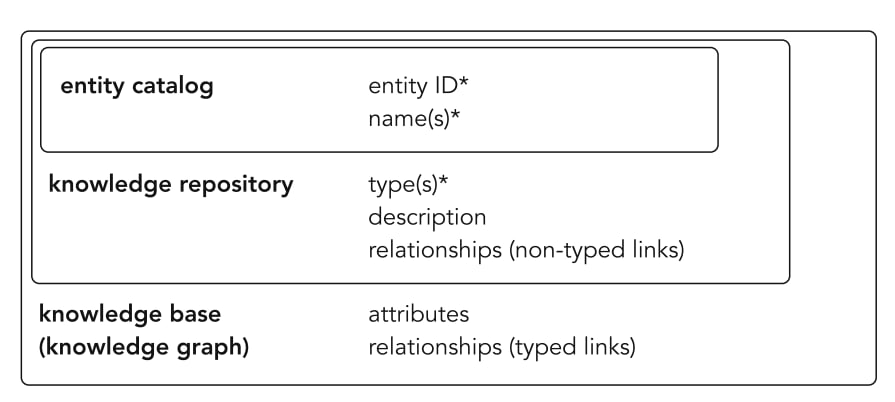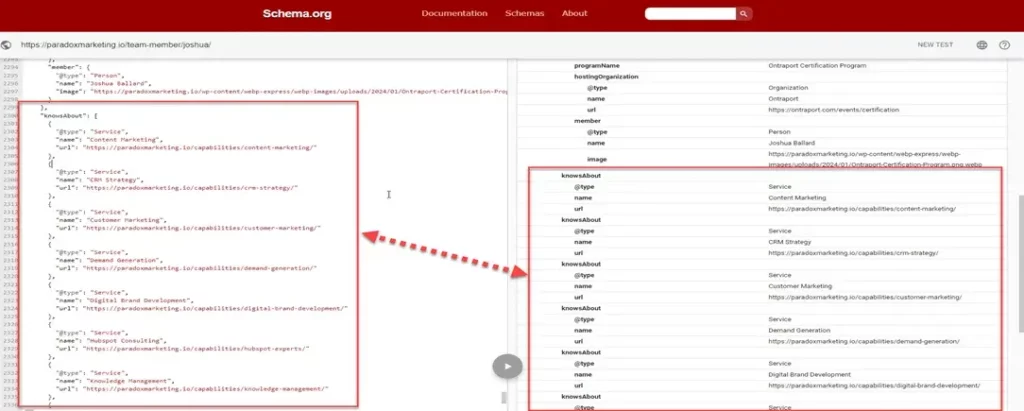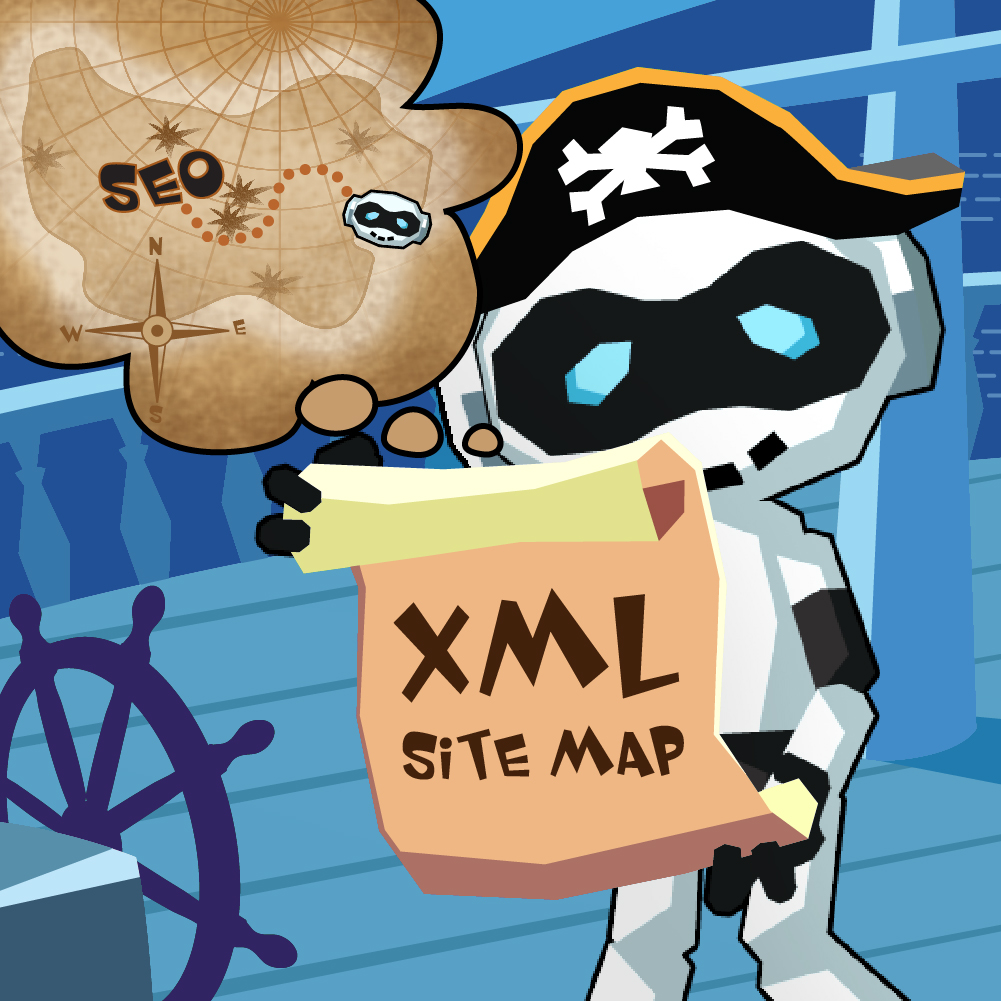
What Exactly Is Entity SEO? And What Role Do Entities Play In Search?
Entity SEO, or entity-based SEO, is a strategic approach to search engine optimization that involves using database ontologies to clearly communicate to search engines the specific nature of a webpage or its sections – or, more accurately, what they represent. This method leverages records from various authoritative databases such as schema.org, Wikidata, and Wikipedia to categorize a particular term or name within a general type.
The process involves a unique coupling: it links a specific name, referring to a particular thing, with a broader type or category. This pairing provides a more comprehensive picture of the content, enabling search engines to understand and classify the webpage more effectively. By doing so, entity SEO helps in aligning the webpage content with the search engine’s knowledge base, thereby enhancing its relevance and visibility in relation to relevant search queries.
The power of entity SEO lies in its ability to disambiguate, clarifying the exact meaning of terms and names, thus ensuring that search engines can differentiate between different entities that might share a name but have distinct identities and contexts.
Entities play a pivotal role in the search ecosystem by serving as the core building blocks for understanding and organizing the web’s vast information in a structured manner. In the realm of search, entities represent real-world objects, concepts, and relationships that search engines can recognize, categorize, and utilize to interpret the content and context of web pages more accurately. This understanding allows search engines to connect users’ search queries with the most relevant and authoritative content available, improving the overall search experience.
By mapping web content to specific entities and their relationships within a global knowledge graph, search engines are better equipped to discern the topical relevance, context, and authority of web pages. This capability enables more sophisticated query processing, allowing search engines to deliver results that are not only keyword-relevant but also contextually aligned with the user’s intent. As a result, entities have become a fundamental aspect of how search engines index, understand, and retrieve information, making entity SEO a critical strategy for anyone looking to optimize content for visibility and engagement in today’s search landscape.
Entities & How Google Search Uses Them to Deal with Ambiguity
Ever wondered how search engines manage to decipher the true intent behind your vague search queries? Take a term like “Lincoln” for example. Without context, it could point to a multitude of things: a car brand, a historical figure, a film, or even a city. Initially, search engines might present a mixed bag of results related to “Lincoln” as they navigate through the ambiguity to match your query with potential interests.
However, the plot thickens when you specify your search to “Lincoln NE.” At this juncture, the brilliance of search engines, particularly powered by Google’s “Related Entities” patent, comes to light. No longer just making educated guesses, the search engine begins to draw from its reservoir of data and the context you’ve provided to home in on your actual search intent.
Enter the realm of Google’s “Related Entities” feature, a backstage maestro guiding search engines in their quest to deliver precision. By appending “NE” to “Lincoln,” the technology deduces that your interest likely lies in Lincoln, Nebraska, rather than the automotive brand, the former president, or the cinematic production. This inference is made possible through the search engine’s ability to recognize “NE” as a definitive marker, narrowing the search scope to the geographic location in question.
The essence of this technology lies in the identification and utilization of relationships between various entities (such as “Lincoln” and “NE”) to streamline and refine search outcomes. Imagine an exceedingly informed librarian who, with just a whisper of your needs, can retrieve the exact piece of information from an extensive repository. This mechanism operates on the principle of analyzing the interconnectedness and frequency of keyword associations across the web, thereby guiding the search engine in curating the most relevant results for you. When “Lincoln NE” is entered, the engine, leveraging entity relationships, sharpens its focus exclusively on the city.
Tips for Entity-based SEO Optimization
Now, you might be pondering, “Great, but how does this benefit me in SEO?” Here’s how to harness the power of entity SEO to your advantage.
Identify and Structure Entity Sets Within Your Website
Create a Knowledge Graph by Linking Entities Intelligently
A knowledge graph represents a sophisticated structure you can develop when architecting the schema for your website. Contrary to the common assumption that applying schema markup is the extent of leveraging structured data, there’s a more profound layer of complexity and utility to be explored. Entities on a website can embody one of three distinct organizational structures, each offering a different level of detail and interconnectivity. This progression underscores the potential to not just mark up content, but to intelligently interlink it, creating a rich, navigable ecosystem of information. As we embark on this exploration, it’s crucial to recognize that the ultimate goal is to construct a knowledge graph. This advanced structure does not merely categorize or enumerate entities but intricately maps their relationships, providing a comprehensive and semantically rich web of data that enhances searchability, user engagement, and overall content value.

Entity Catalog
At the most basic level, an entity catalog serves as a directory of entities. Entities, in this context, are distinct objects, concepts, people, or places that can be uniquely identified and named. The primary goal of an entity catalog is to ensure that each entity is distinguishable from others, thus preventing ambiguity. This structure is particularly useful for basic data organization tasks, such as cataloging products in an e-commerce database or listing articles in a content management system. The entity catalog focuses on identification and disambiguation, providing a solid foundation for more advanced data structures.
Knowledge Repository
Building upon the entity catalog, a knowledge repository adds depth to each listed entity. It not only identifies and names entities but also categorizes them and describes them in detail. Furthermore, it begins to introduce relationships among entities, albeit in a basic or untyped form. These relationships might indicate association but do not specify the nature of the connections in detail (for example, “related to” without indicating how). A knowledge repository enhances the contextuality and interconnectedness of the data, making it more useful for applications requiring a moderate level of data interrelation and semantic richness.
Knowledge Graph
The knowledge graph represents the pinnacle of entity organization and semantic connectivity. It transforms the basic interrelations of a knowledge repository into a dense network of typed relationships among entities. This means each relationship is defined by a specific, meaningful type (for example, “authored by” or “located in”), which illustrates not just the fact of a connection but its precise nature. Knowledge graphs enable a deep semantic understanding of the data, facilitating advanced search, discovery, and recommendation capabilities. They are instrumental in powering search engine algorithms, enhancing SEO through detailed, context-aware indexing and retrieval.
In planning a knowledge graph, pointers play a crucial role. They are not mere links but structured references that define and elucidate the relationships between entities within the schema, making the knowledge graph a powerful tool for representing complex, real-world relationships in a digital format. This structured approach to data organization goes beyond simple categorization, enabling a nuanced understanding of how entities interact within a given domain, which is invaluable for SEO and content discovery.
Understanding these structures—from the foundational entity catalog to the complex knowledge graph—is essential for anyone looking to enhance their website’s or application’s visibility and navigability in an increasingly data-driven and semantically oriented digital environment.
Here’s an example of how a profile pages can be connected to service pages:

Ditch The Automatic Schema Markup Generated by Most SEO Tools
Automated SEO tools serve as a convenient starting point for schema markup, but they often fall short in weaving the complex web of connections that constitute a knowledge graph. These tools can efficiently identify and tag individual elements on your site but typically don’t link these elements to one another in a meaningful way. In other words, often schema generated by most plugins create only an entity catalog.
Manually curating your schema markup compensates for these shortcomings. It allows you to meticulously map out how different aspects of your site — like a physician, their treatments, and the conditions they address — interlink, much like chapters of a book. This manual process forms a comprehensive network, or a “topical map,” which significantly aids search engines in navigating and understanding the thematic structure of your content.
Automated tools lack the sophistication to create references between related entities, resulting in a fragmented schema that doesn’t fully communicate the depth of your site’s information to search engines. By manually establishing these connections, you ensure a cohesive and intelligible structure, enhancing your site’s visibility and searchability.
Align Your Content Strategy With Your Entity Base
Aligning your content strategy with your entity base is essential for capturing the full spectrum of search opportunities. This process involves adapting your website’s content to include a broader range of entities and page types, guided by keyword research and user intent analysis. Here’s a streamlined approach to achieve this alignment:
- Conduct keyword research: Start with thorough keyword research to uncover how users search for information related to your primary entities (such as treatments, conditions, and symptoms in a medical site). This step will help you identify gaps in your content and potential new entities or concepts to include.
- Match intent with entities: Analyze the intent behind the keywords you’ve identified. Are users looking for information, guidance, or specific services? This understanding will help you match keywords not just to entities but to the correct type of content, such as informative articles, guides, or how-to pages.
- Incorporate relevant page types: Based on your findings, consider incorporating new page types that align with user intent. For instance, if “how-to” content is highly sought after, develop how-to guides that tie back to your main entities, enriching your site’s content landscape.
- Optimize for new entities: As you expand your content, integrate new entities and optimize existing ones. This might mean adding anatomical pages to a medical website, enhancing both the depth of information provided and its SEO potential.
- Refine through feedback and performance: Use site analytics and user feedback to refine your approach, ensuring your content not only meets user needs but also enhances visibility and engagement.
By starting with keyword research and aligning your content with both user intent and your evolving entity base, you can create a more dynamic, informative, and searchable website.
Optimize Your Semantic Anchor Texts and Internal Link Graph to Corroborate and Support Your Entity Base
Strengthening your entity base requires a concerted effort in refining the anchor texts and the internal link structure of your website. Implementing these strategies will enhance the support and corroboration for your entities:
- Semantic anchor text optimization: Craft anchor texts for internal links using language that encapsulates the essence and context of the linked entity’s content. For example, use “Dr. Jane Doe’s arthritis treatment approach” instead of generic phrases like “click here” when linking to a physician’s profile.
- Contextual internal linking: Establish logical and semantically related internal links. Linking should reflect the relational depth between entities, such as connecting nutritional advice blog posts directly to dietitians’ profiles or relevant service offerings.
- Anchor text variability and relevance informed by data: Leverage Google Search Console to identify variations in user queries that direct traffic to your pages. Incorporate these variations into your anchor texts to maintain relevance and introduce natural diversity. This method strengthens the destination URL’s entity association and introduces variability in a way that is informed by actual user search behavior.
- Internal link graph analysis: Use analytical tools to review your site’s internal link structure. Ensure that crucial entity pages are emphasized with a greater number of relevant internal links, signaling their significance to search engines.
- Cross-linking between entity sets: Where relevant, establish cross-links between different entity sets, such as treatments and conditions. This enhances navigational ease for users and solidifies the semantic connections between entities.
- Leverage breadcrumbs for hierarchical linking: Implement breadcrumbs to delineate the site’s hierarchy. This helps users navigate and allows search engines to understand the layered relationship between categories and individual entity pages.
- Audit and refine: Conduct regular audits of your anchor texts and internal linking to ensure they continue to validate and support your entity base, especially as new content and entities are introduced.
By meticulously optimizing your semantic anchor texts and internal linking, you create a network that not only improves user navigation but also communicates a clear and semantically rich structure to search engines, bolstering the overall integrity and visibility of your entity framework.
Maximizing SEO Potential Through Strategic Entity Integration
The journey towards SEO excellence is perpetual, with entity SEO at its core offering a sophisticated avenue to enhance your website’s relevance and discoverability. Embracing entities enables a direct line of communication with Google, ensuring your content is not only seen but understood in the vast digital expanse.
Entity Optimization: The SEO Game Changer
Incorporating entity optimization into your SEO strategy is not just about staying ahead in the search rankings; it’s about establishing a clear and authoritative voice in your domain. Each entity you define and each relationship you map out contributes to a richer, more connected web of information, deeply rooted in context and relevance.
A Unified Approach to Content and Entity Alignment
Aligning your content with your entity base goes beyond mere keyword integration. It’s about crafting content that resonates with both your audience and search engines. By continuously adapting and expanding your entity base in line with keyword research and user intent, you ensure that your website remains a dynamic and authoritative source of information.
Partner with Paradox Marketing
In the realm of entity SEO, the path to optimization is intricate and requires a nuanced understanding of both your content and how it’s perceived by search engines. This is where Paradox Marketing, “Your Marketing Department,” steps in. Our SEO team is adept at strategizing and implementing entity-based optimizations that align with Google’s evolving algorithms, ensuring your website not only ranks well but also truly connects with your audience.
Whether you’re looking to refine your entity base, enhance your content strategy, or overhaul your website’s semantic structure, our team is equipped to guide you through each step of the process. By partnering with Paradox Marketing, you’re not just optimizing your website; you’re future-proofing your digital presence in an ever-competitive online landscape. We’ve held a lot back. Give us a call and we can really get into the details.
Take the leap towards transformative SEO success
Reach out to Paradox Marketing today and start strategizing with a team that understands the depth and potential of entity SEO. Let us help you turn your website into a beacon of relevance and authority, seamlessly connecting with both Google and your desired audience.








